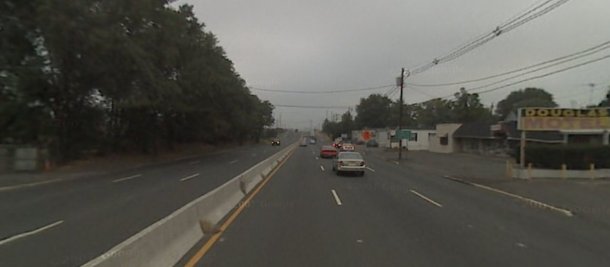Heeding the call from Tri-State and other groups, the New Jersey Department of Transportation has adopted a complete streets policy, signed by Commissioner Stephen Dilts on December 10th. Complete streets is a policy that requires new or rehabilitated roads to be built for all users, including walkers, cyclist, transit riders, and drivers.
Following Connecticut’s passage of Senate Bill 735 this summer, NJ is the second state in our region to make complete streets official policy. New York currently has a complete streets bill pending in the State Legislature.

NJ’s departmental policy establishes “a checklist of pedestrian, bicycle and transit accommodations” like sidewalks, crosswalks, bike lanes, and medians, “with the presumption that they shall be included in each project” constructed by the department. It represents progress for an agency that has been backsliding under the Corzine Administration and losing its title as one of the most innovative transportation departments in the country.
Unfortunately, the policy contains overly broad exceptions and lacks any public process, both of which could undermine its effectiveness.
The policy contains five enumerated exceptions, reprinted below. They include exceptions for safety, cost, and lack of need that are present in most existing complete streets policies. However, NJ adds an exception where the “timing of a project is compromised by the inclusion of complete streets.” It is not difficult to foresee abuse of this exception. Adding complete street features to a construction project that did not previously include them can potentially lengthen the project’s timeline. The policy document offers no guidance as to what length of time may count as significant.
The real danger resides in an exemption that allows project engineers to ignore the requirements of the policy for any reason, so long as it is internally documented and approved by the Capital Program Committee and Commissioner. Public input is left unmentioned in this, or any other section, of the policy. Contrast this to a similar exception proposed in Delaware where waivers are very limited and subject to two appeal levels and approval by up to nine officials.
Still, the policy is a good step and gives Governor-elect Christie’s administration an opportunity to strengthen the policy and ensure New Jersey Department of Transportation regains its foothold as a innovative and sustainable transportation leader.
Comparing Exemptions in Tri-State Policies:
For comparison, here are the exemption sections from Connecticut’s law, New York’s proposed legislation, and New Jersey’s complete streets policy. While each contains overly broad categories for exempting projects, NJ includes and expands the exemptions to the point that the policy directive can be rendered meaningless:
“Exemptions to the Complete Streets policy must be presented for final decision to the Capital Program Screening Committee in writing by the appropriate Assistant Commissioner and documented with supporting data that indicates the reason for the decision and are limited to the following:
1) Non-motorized users are prohibited on the roadway.
2) Scarcity of population, travel and attractors, both existing and future, indicate an absence of need for such accommodations.
3) Detrimental environmental or social impacts outweigh the need for these accommodations.
4) Cost of accommodations is excessively disproportionate to cost of project, more than twenty percent (20%) of total cost.
5) The safety or timing of a project is compromised by the inclusion of Complete Streets.
An exemption other than those listed above must be documented with supporting data and must be approved by the Capital Program Committee along with written approval by the Commissioner of Transportation.”
The NJDOT policy is reprinted here (it is not officially available yet).
Connecticut’s complete streets law:
“(d) The provision of facilities pursuant to subsection (c) of this section shall not be required if the Commissioner of Transportation or a municipal legislative body determines, with respect to a highway, road or street that: (1) Nonmotorized usage is prohibited; (2) there is a demonstrated absence of need; (3) the accommodation of all users would be an excessively expensive component of the total project cost; or (4) the accommodation of all users is not consistent with the state’s or such municipality’s, respectively, program of construction, maintenance and repair.”
New York’s proposed bill:
“(B) Exceptions to paragraph (A) of this subdivision shall be permissible only after the transportation agency or agency with jurisdiction of the project fully demonstrates, with supporting documentation which shall be available to the public, that one of the following exists:
(I) use by bicyclists and pedestrians is prohibited by law, such as within interstate highway corridors;
(II) establishment of such accommodations would be contrary to public safety;
(III) the cost would be excessively disproportionate to the need or probable use; or
(IV) scarcity of population or other available means or factors indicate an absence of future need.
Image: Google Maps.

[…] New Jersey's New "Complete Streets" Policy Fraught With Holes (MTR) […]
The lame-duckness of this move not worth mentioning? Will Christie’s DOT support or embrace even this swiss-cheese version?
[…] New Jersey's New "Complete Streets" Policy Fraught With Holes (MTR) […]
[…] looking at recent progress by both the state and advocates, including NJDOT’s adoption of a Complete Streets Policy, the first New Jersey Bicycle Summit, a surge in community bike groups in cities like Asbury Park, […]
[…] the New Jersey Department of Transportation’s adoption of a complete streets policy in 2009 has led to some pedestrian- and cyclist-friendly improvements […]
[…] has been a strong movement for complete streets in the Garden State, with NJDOT, five counties and over ten percent of municipalities in New Jersey now having passed complete […]